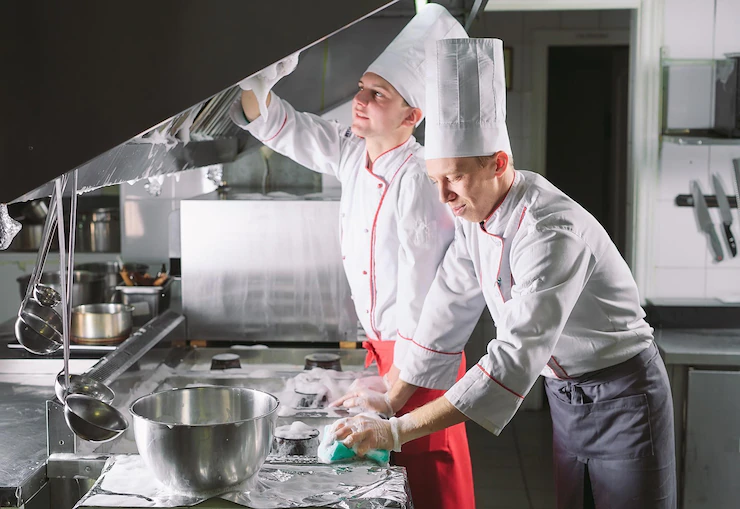When designing a commercial kitchen, efficiency is everything. Also, finding a commercial kitchen for rent is a tiresome task. If your kitchen is properly laid out and optimized, it’ll have a positive impact on almost every aspect of your business. The question is, where do you start?
We have brought a detailed guide on designing an efficient commercial kitchen. Give it a read.
What Is A Commercial Kitchen?
The primary question we will be targeting is what is a commercial kitchen? The commercial kitchen is a hotel, house, restaurant, bar, or any other hospitality type business whose key focus is to prepare food for the customers.
You may start looking for “commercial kitchen near me” on Google but trust me, you need a guide like this to be able to identify the best one.
6 Tips for More Efficient Commercial Kitchen Design:
With commercial kitchens, productivity, efficiency, and speed is the name of the game. But you can’t let your pursuit of these things compromise food safety or quality. You have to carefully prioritize each of these elements. Keeping this in mind, here are several ways to build, optimize, or redesign a kitchen to ensure it’s as efficient as possible.
1. Aim for Flexibility and Modularity
It’s unwise and shortsighted to assume that your kitchen’s needs will always be the same as they are today. Businesses grow, need change, and you don’t want to be married to one specific layout or setup. This is why flexibility and modularity are so important.
Ideally, you want to create as many multi-purpose spaces and surfaces as you can. This allows you to adapt them over time to fit different needs. And when it comes to cabinets and appliances, building them on heavy-duty casters gives you the flexibility to move large pieces around in the future.
2. Think About the Flow of Materials
Always be aware of the flow of materials and people. Think about kitchen design through the lens of processes. Because while your kitchen is a busy environment, it does not have to be a chaotic place. When your kitchen is designed logically around materials and personnel, efficiency is a natural byproduct.
“The refrigerated and dry storage areas should be near the receiving area, for example, but the waste disposal and dishwashing areas should be separate from the food preparation and meal cooking areas,” Webstaurant explains. If you’re unsure of what your restaurant’s flow is, spend some time observing your kitchen staff during a busy period. Watch, listen, observe, and ask questions. You’ll start to get a feel for where there’s friction.
Related Resource: How to Decorate Your Kitchen or Dinner
3. Place Food Storage Near Food Prep
Speaking of the flow of materials, this is one simple thing you can do to save your staff precious minutes every single day. By placing food storage near food prep stations, you cut down on the need to criss-cross the kitchen. Instead, your staff can just reach and place (This sounds like a small thing, but it can actually have a noticeable impact on speed and efficiency).
4. Make Sanitation Easy
Sanitation is a big part of running a commercial kitchen. Not only do you owe it to your employees and customers, but you could get some major fines and slaps on the wrist for failing to meet basic health code requirements. Having said this, make sanitation as easy as you possibly can.
For starters, use the right materials. Most wall materials are not made for commercial kitchen applications (yet are still used). Opting for something that’s specifically manufactured for kitchen environments – like Trusscore panels – makes it a whole lot easier to keep your spaces clean.
5. Be Smart With Air Ventilation
It might seem like a small detail in the grand scheme of things, but air ventilation systems can make or break your kitchen. More specifically, you have to pay attention to placement. Foodservice exhaust hoods should be placed in the correct positions to pass safety codes and keep your kitchen clean and free of residue, grease, and other debris that’s left behind from exhaust gasses.
6. Consult a Professional
Does this all sound like a bit too much? You don’t have to tackle commercial kitchen equipment layout and optimization on your own. There are actually professional commercial kitchen designers who do this for a living. Leaning on one of these designers can remove a big task from your plate and allow you to focus on more important responsibilities like running your business.
Putting it All Together
Commercial kitchen design plays a critically important role in both the efficiency of your kitchen and the quality and safety of the food being prepared. Hopefully, this article gives you some tangible ideas that you can implement right away. Good luck!
Have any questions? Let’s meet in the comment section below.
For more updates on topics like this, keep an eye out for our website.
Read Also:





























